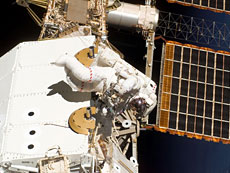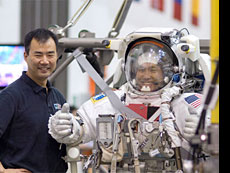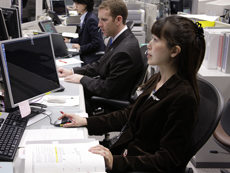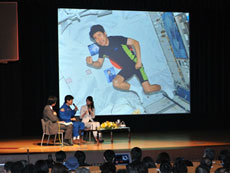


Q. What is it like for an astronaut to work in space?

STS-123 astronauts getting ready for the assembly of the Kibo's Logistics Module. (Courtesy of NASA)

Astronauts perform various tasks in space, but at the moment our work is dominated by the assembly of the ISS, which will be followed by long-term expeditions to perform various system operations, experiments, and observations. To build the space station, we perform many tasks including using robotic arms to attach the modules, connecting electrical wires and coolant hoses for the thermal control system, and booting up new systems installed on the ISS.
The ISS is about to transition from its current construction phase to an actual functional phase. The first of JEM Kibo's large laboratories, the Pressurized Module, has recently been assembled in space. The second large laboratory of Kibo, the Exposed Facility, will be added in the near future. After the assembly of Kibo is completed, various experiments using these laboratories will be performed in orbit. This will begin the practical use of Kibo.
Japanese astronauts will participate on various long expeditions, which we hope will lead to the development of other manned space activities, such as the construction of a lunar base and facilities for planetary exploration. Thus, the work of astronauts will continue to expand.
Q. After being assigned to a mission, what kind of training and lifestyle will astronauts experience before the actual flight?

Astronaut Wakata (right) and Astronaut Noguchi (left) before training for extra-vehicular activities.
There are two kinds of space flights that Japanese astronauts are assigned to at the moment. One is a Space Shuttle mission to assemble the ISS, and the other is a long-duration expedition on the ISS, which lasts several months. The training for these two types of space flight is very different. In March 2008, Astronaut Takao Doi did a great job on the first Kibo assembly mission. Astronaut Akihiko Hoshide was also just as successful in the second Kibo assembly mission which recently concluded in June.
For the ISS assembly flights in which Astronauts Doi and Hoshide participated, most of the training took place at NASA's Johnson Space Center in Houston, Texas, in the United States, except for some of the training for the Kibo assembly in Tsukuba, Japan. An astronaut is assigned to the mission at least one year before the launch and trains for the assembly operations mainly in Houston by practicing using all of the systems on the Space Shuttle and the robotic arms on the ISS as well as by simulating space walks in the huge pool at the Neutral Buoyancy Lab (NBL). The training to boot up Kibo's controls and data, electrical, and environment-control systems took place both in Tsukuba and in Houston.
Training for long-duration ISS expeditions start at least two years prior to the flight. Fifteen nations are participating in the ISS project, and each one has developed its own components such as experiment/habitation modules and robotic systems. Since the astronauts assigned to the long-duration expeditions need to control and operate all these systems, there is an agreement that the country which designed the experiment module or other element is responsible for training astronauts in its use. Therefore, astronauts who are assigned to the long-duration expeditions need to go to Japan, the United States, Russia, Canada, and Europe for training. The longest training periods are in the U.S. and Russia, as they each have many ISS modules and space transportation systems.
Q. Is there anything that is prohibited in an astronaut's normal daily life?
There is nothing specifically prohibited in an astronaut's normal daily life, but starting one year before the flight, participating in such activities as racing (such as auto, boat, plane, motorcycle), skiing, skydiving, and fire-fighting are prohibited, as they are considered high-risk. Starting eight months before the flight, playing sports such as baseball, softball, and basketball are also prohibited. These bans are in place to avoid delaying the space flight as a result of injuries to the astronauts.
Q. What kind of work do astronauts who are not assigned to the mission perform?

Astronaut Yamazaki supporting the space flight by communicating with STS-123 crewmembers in the Kibo Mission Control Room at the Tsukuba Space Center in Japan.

To tell you the truth, the greatest part of an astronaut's work is performed while we are not assigned to a mission, and this varies widely. For example, a Capsule Communicator (or Capcom) is a member of the mission control team in the mission control center on the ground and supports the space flight by communicating directly with the astronauts on the ISS or the Space Shuttle.
It is also important for the astronauts to participate in the development of various space systems on the Space Shuttle, the ISS, and even the United States' next-generation spaceship Orion, and to bring their operational experience in space to the operational performance tests.
Offering support to the family members of astronauts in flight is another important job for fellow astronauts. During each flight, the astronauts assigned to family support are in charge of communication between the families of the astronauts and the Astronaut Office. They also support these families on-site at the time of launch and landing. I feel really secure knowing that my fellow astronauts are taking care of my family while I am away.
For a long time, I have participated in the development of various systems for the JEM Kibo, specifically the robotic arms and extra-vehicular activities. I attended development meetings with the engineers who actually created these systems and also participated in quite a few simulations to evaluate the safety and reliability of the systems.
In addition, there are various kinds of ground work, such as technical support for the operation of the ISS and Space Shuttle systems, training support as an instructor astronaut, or examinations of the safety of medical experiments on astronauts led by astronauts specializing in medicine.
Q. What are some examples of an astronaut's activities that can have an impact on our lives on Earth?

A scene from a meeting with Astronaut Doi after his return from the STS-123 mission.
Among the various tasks that an astronaut performs, I think the field of publicity is one that provides many opportunities for us to be in contact with people. A typical example of this work is to share with everyone how wonderful and fun space science and space development can be through activities such as lectures, publicity events, educational programs, and media interviews.
In addition, new knowledge and technologies that are useful in our daily lives have been generated through space development and exploration. We call these spin-offs, and there are many examples:
- A computer program to calculate the strength of a structure needed to build a spaceship has been applied to design shoes, especially running shoes, as well as ships, trains, and cars.
- JAXA is going to take 28 kinds of authorized space food to the ISS, and this technology for space-food development is also being applied to control safety and hygiene for ordinary food on Earth.
- On the ISS, we have to recycle the limited amount of water. The water purification technology used in space is also another form of technology that has been extended to enhance our daily lives on Earth.
- The results of some space experiments have contributed to the development of new medicines.
When the JEM Kibo is completed, there will be more opportunities for Japanese astronauts to stay in space for longer periods. Meanwhile, in the space medicine field, more important data and technologies will be obtained such as in remote medicine. For example, when I stay on the ISS for a long-duration expedition, there will be three astronauts working together for several months: an American, a Russian, and myself. During the expedition, the devices and systems to monitor an astronaut's health are used with the support of doctors on the ground. The technology of these devices can be applied to remote medicine during disasters, so that doctors can diagnose and treat patients from remote locations. In addition, if you stay in zero-gravity for a long period, regardless of your age or sex, the density of your bones decreases, and the bones become fragile. This is known as osteoporosis. Various research is being promoted to prevent osteoporosis, and if we can investigate the mechanism of how this can be prevented in space, it can be applied to ground medicine as well. So, as you can see, through manned space activities, various achievements are being made that are directly related to our daily lives on the ground.

STS-123 astronauts getting ready for the assembly of the Kibo's Logistics Module. (Courtesy of NASA)
Astronauts perform various tasks in space, but at the moment our work is dominated by the assembly of the ISS, which will be followed by long-term expeditions to perform various system operations, experiments, and observations. To build the space station, we perform many tasks including using robotic arms to attach the modules, connecting electrical wires and coolant hoses for the thermal control system, and booting up new systems installed on the ISS.
The ISS is about to transition from its current construction phase to an actual functional phase. The first of JEM Kibo's large laboratories, the Pressurized Module, has recently been assembled in space. The second large laboratory of Kibo, the Exposed Facility, will be added in the near future. After the assembly of Kibo is completed, various experiments using these laboratories will be performed in orbit. This will begin the practical use of Kibo.
Japanese astronauts will participate on various long expeditions, which we hope will lead to the development of other manned space activities, such as the construction of a lunar base and facilities for planetary exploration. Thus, the work of astronauts will continue to expand.
Q. After being assigned to a mission, what kind of training and lifestyle will astronauts experience before the actual flight?

Astronaut Wakata (right) and Astronaut Noguchi (left) before training for extra-vehicular activities.
For the ISS assembly flights in which Astronauts Doi and Hoshide participated, most of the training took place at NASA's Johnson Space Center in Houston, Texas, in the United States, except for some of the training for the Kibo assembly in Tsukuba, Japan. An astronaut is assigned to the mission at least one year before the launch and trains for the assembly operations mainly in Houston by practicing using all of the systems on the Space Shuttle and the robotic arms on the ISS as well as by simulating space walks in the huge pool at the Neutral Buoyancy Lab (NBL). The training to boot up Kibo's controls and data, electrical, and environment-control systems took place both in Tsukuba and in Houston.
Training for long-duration ISS expeditions start at least two years prior to the flight. Fifteen nations are participating in the ISS project, and each one has developed its own components such as experiment/habitation modules and robotic systems. Since the astronauts assigned to the long-duration expeditions need to control and operate all these systems, there is an agreement that the country which designed the experiment module or other element is responsible for training astronauts in its use. Therefore, astronauts who are assigned to the long-duration expeditions need to go to Japan, the United States, Russia, Canada, and Europe for training. The longest training periods are in the U.S. and Russia, as they each have many ISS modules and space transportation systems.
Q. Is there anything that is prohibited in an astronaut's normal daily life?
There is nothing specifically prohibited in an astronaut's normal daily life, but starting one year before the flight, participating in such activities as racing (such as auto, boat, plane, motorcycle), skiing, skydiving, and fire-fighting are prohibited, as they are considered high-risk. Starting eight months before the flight, playing sports such as baseball, softball, and basketball are also prohibited. These bans are in place to avoid delaying the space flight as a result of injuries to the astronauts.
Q. What kind of work do astronauts who are not assigned to the mission perform?

Astronaut Yamazaki supporting the space flight by communicating with STS-123 crewmembers in the Kibo Mission Control Room at the Tsukuba Space Center in Japan.
To tell you the truth, the greatest part of an astronaut's work is performed while we are not assigned to a mission, and this varies widely. For example, a Capsule Communicator (or Capcom) is a member of the mission control team in the mission control center on the ground and supports the space flight by communicating directly with the astronauts on the ISS or the Space Shuttle.
It is also important for the astronauts to participate in the development of various space systems on the Space Shuttle, the ISS, and even the United States' next-generation spaceship Orion, and to bring their operational experience in space to the operational performance tests.
Offering support to the family members of astronauts in flight is another important job for fellow astronauts. During each flight, the astronauts assigned to family support are in charge of communication between the families of the astronauts and the Astronaut Office. They also support these families on-site at the time of launch and landing. I feel really secure knowing that my fellow astronauts are taking care of my family while I am away.
For a long time, I have participated in the development of various systems for the JEM Kibo, specifically the robotic arms and extra-vehicular activities. I attended development meetings with the engineers who actually created these systems and also participated in quite a few simulations to evaluate the safety and reliability of the systems.
In addition, there are various kinds of ground work, such as technical support for the operation of the ISS and Space Shuttle systems, training support as an instructor astronaut, or examinations of the safety of medical experiments on astronauts led by astronauts specializing in medicine.
Q. What are some examples of an astronaut's activities that can have an impact on our lives on Earth?

A scene from a meeting with Astronaut Doi after his return from the STS-123 mission.
In addition, new knowledge and technologies that are useful in our daily lives have been generated through space development and exploration. We call these spin-offs, and there are many examples:
- A computer program to calculate the strength of a structure needed to build a spaceship has been applied to design shoes, especially running shoes, as well as ships, trains, and cars.
- JAXA is going to take 28 kinds of authorized space food to the ISS, and this technology for space-food development is also being applied to control safety and hygiene for ordinary food on Earth.
- On the ISS, we have to recycle the limited amount of water. The water purification technology used in space is also another form of technology that has been extended to enhance our daily lives on Earth.
- The results of some space experiments have contributed to the development of new medicines.
When the JEM Kibo is completed, there will be more opportunities for Japanese astronauts to stay in space for longer periods. Meanwhile, in the space medicine field, more important data and technologies will be obtained such as in remote medicine. For example, when I stay on the ISS for a long-duration expedition, there will be three astronauts working together for several months: an American, a Russian, and myself. During the expedition, the devices and systems to monitor an astronaut's health are used with the support of doctors on the ground. The technology of these devices can be applied to remote medicine during disasters, so that doctors can diagnose and treat patients from remote locations. In addition, if you stay in zero-gravity for a long period, regardless of your age or sex, the density of your bones decreases, and the bones become fragile. This is known as osteoporosis. Various research is being promoted to prevent osteoporosis, and if we can investigate the mechanism of how this can be prevented in space, it can be applied to ground medicine as well. So, as you can see, through manned space activities, various achievements are being made that are directly related to our daily lives on the ground.